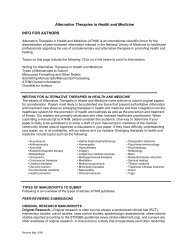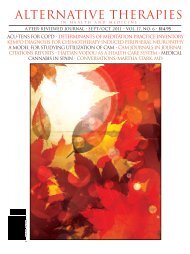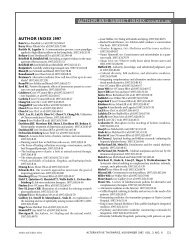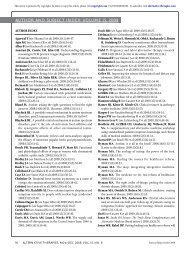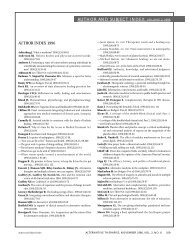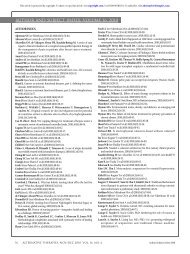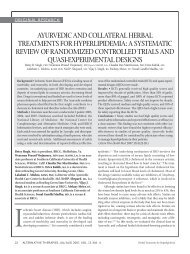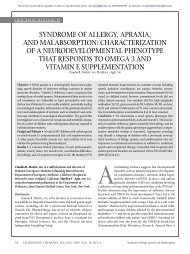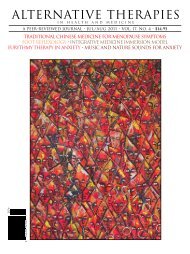Alternative Therapies In Health And Medicine
Alternative Therapies In Health And Medicine
Alternative Therapies In Health And Medicine
You also want an ePaper? Increase the reach of your titles
YUMPU automatically turns print PDFs into web optimized ePapers that Google loves.
over 2 years. 22 Two previous studies found beneficial effects of AM<br />
therapies on anxiety in cancer patients. 23,24<br />
Here we present the case of a patient suffering from unspecified<br />
anxiety that was treated with an AM treatment—EYT—and<br />
showed a remarkable improvement. Clinical observations, AM<br />
diagnosis, and treatment are described in the text, and the theoretical<br />
background is outlined in the sidebar on page 63..<br />
Case presentation<br />
History, Presenting Condition, and Diagnosis<br />
A 21-year-old Swedish woman had collapsed after a busy and<br />
stressful working period in summer 2003. She then suffered from<br />
increasing episodes of heart palpitations and fainting; increasing<br />
symptoms of dizziness and feelings of being disconnected; unrest;<br />
fear of being alone, of having cancer, of death; social anxiety; difficulty<br />
in making decisions; headache; sleeplessness; tingling in the<br />
fingertips, soles of the feet, and left side of the face; nausea; bruxism;<br />
and muscular pains, especially in the neck. Often she woke up<br />
at night because of anxiety. Symptoms had led to the consultation<br />
of an emergency hospital department, but no organic cause (eg,<br />
heart trouble, hypo- or hypertension, infection) was found.<br />
From August 2003 onward, the young woman consulted the<br />
Family Physician Care Centre of the Swedish AM Vidarkliniken for<br />
her anxiety. Here, three physicians (one pediatrician and two general<br />
practitioners, one of whom had been the patient’s family physician<br />
for many years [PA]) saw the patient and made the same<br />
diagnosis: stress-induced unspecific anxiety (in detail: unspecified<br />
anxiety [<strong>In</strong>ternational Classification of Diseases (ICD) code F41.9],<br />
reaction to stress [ICD code F43.9], and cervical myalgia [ICD code<br />
M79]). Important in her medical history was both a traumatic<br />
exposure to emotionally stressful family relationships when she was<br />
aged 9 to 11 years and the painful experience of the protracted lifethreatening<br />
illness of her mother when the patient was aged 11 to<br />
13 years. Between ages 16 and 19, the patient had moderately severe<br />
anorexia. <strong>In</strong> addition, she had suffered from several manifestations<br />
of anxiety in her childhood, such as obsessive cleanliness, anxiety<br />
about contamination, and fear of infection with intestinal parasites.<br />
Otherwise, there were no major illnesses or events. Physical, neurological,<br />
and laboratory findings were normal except for myalgia in<br />
the upper back and neck region.<br />
From Vidarkliniken, the patient was given immediate sick leave<br />
from work, first 100% and 3 weeks later 50%. She received outpatient<br />
treatment with AM back embrocation and medicine (20 drops T<br />
Cardiodoron 3 times daily; Aurum D10/Stibium D8 twice daily; 15<br />
drops Arnica D3 3 times daily) and received some instructions for selfhelp<br />
behavioral approaches. Despite the treatment, her condition further<br />
deteriorated during the following 2 months. Her anxiety<br />
increased so that she was unable to be with others or to leave her<br />
home. Her sick leave was increased again to 100%, and her AM medication<br />
was changed (20 drops Bryophyllum Argento culta 1% 3 times<br />
daily and subcutaneous injections Argentum D6 + Conchae D7 3 times<br />
weekly). Additionally from October 2003 onward, she received counseling<br />
of a supportive and confirmative nature at a nearby psychiatric<br />
outpatient hospital for young people. However, her condition<br />
improved little. The patient was dejected by the slow development<br />
and her inability to actively contribute to the treatment. The physician<br />
(PA) anticipated that about 2 years of treatment were needed in<br />
order to achieve a substantial improvement.<br />
Anthroposophic <strong>Medicine</strong> Diagnosis<br />
Against the background of the anthroposophic concept (see<br />
the sidebar), the psychological trauma in the patient’s second 7-year<br />
age period were seen as to have impacted on two closely connected<br />
aspects of the human maturation: the emotional life with special<br />
regard to inwardness and the rhythmic system. Disturbances in this<br />
specific maturation process can lead to mental/emotional symptoms:<br />
that is to say, depression or anxiety. Therefore, the patient’s<br />
anxiety was interpreted as an after-effect of her traumatic juvenile<br />
experiences. Accordingly, the AM specific diagnosis was stress-induced<br />
anxiety based on a juvenile rhythmic system disturbance.<br />
<strong>In</strong> view of this diagnosis, the physician decided on a eurythmy<br />
treatment.<br />
Anthroposophic <strong>Medicine</strong> Treatment: Eurythmy Therapy<br />
EYT (eurythmy from the Greek meaning “harmonious<br />
rhythm”) is a movement therapy involving cognitive, emotional,<br />
and volitional elements. It is provided by EYT therapists with 5<br />
years of training according to an international standardized curriculum.<br />
25 EYT is conducted mainly in individual sessions during which<br />
patients are instructed to perform specific movements with the<br />
arms, the legs, or the whole body. These movements are related to<br />
the sounds of vowels and consonants, to music intervals, or to soul<br />
gestures (eg, sympathy-antipathy) and are named accordingly. They<br />
are selected depending on the patient’s disease, constitution, and<br />
current pattern of postures, gestures, and movements as far as these<br />
express the patient’s vitality and spirit-soul levels. 26,27<br />
<strong>In</strong> our patient, EYT was indicated in order to (1) treat the<br />
patient’s rhythmic system and thereby consolidate her both physically<br />
and emotionally and (2) strengthen her personality so that she<br />
could meet the demands of impending adulthood.<br />
EYT was started at the Vidarkliniken Day Rehabilitation in<br />
January 2004, 6 months after the initial consultation for anxiety.<br />
EYT was conducted for 8 weeks, one session per week lasting 30<br />
minutes; between sessions, the patient practiced the exercises on<br />
her own. Before the EYT sessions, the patient received an<br />
AM-specific massage including kidney embrocation using copper<br />
ointment, after which she rested in a private room.<br />
After each session, the EYT therapist (JS) documented her<br />
observations, treatment decisions, and therapeutic intentions.<br />
Concomitant <strong>Therapies</strong><br />
October 2003 to February 2004: 20 drops Bryophyllum<br />
Argento culta 1% three times daily; subcutaneous injections Argentum<br />
D6 + Conchae D7 three times per week;<br />
October 2003: Supportive counseling once a week until May<br />
2004: thereafter, once a month until November 2004;<br />
January 2004 to March 2004: AM-specific massage including<br />
kidney embrocation using copper ointment;<br />
February 2004 to May 2004: dil Bryophyllum Argento culta 1%,<br />
Eurythmy Therapy in Anxiety<br />
ALTERNATIVE THERAPIES, jul/aug 2011, VOL. 17, NO. 4 57



